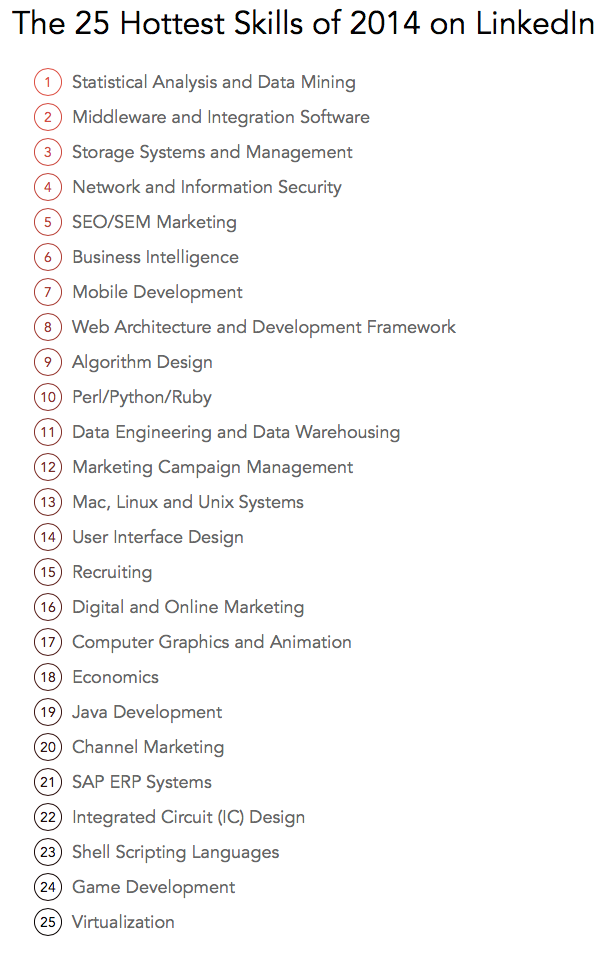The 25 Hottest Skills That Got People Hired in 2014
Believe it or not, 2014 is almost over and 2015 is right around the corner. With a new year comes new opportunities, and around this time we at LinkedIn are typically asked the following question: “Who’s getting hired and what are they doing?”
To get to an answer, we analyzed the skills and experience data in over 330 million LinkedIn member profiles. If your skills fit one of the categories below, there’s a good chance you either started a new job, garnered the interest of a recruiter in the past year, or won new clients.
In addition, we took at look at the top skills in several countries including Australia, Brazil, Canada, France, India, the Netherlands, South Africa, United Arab Emirates, the United Kingdom, and the United States. Each country's top 25 skills are included in a SlideShare below. A few skills trends stood out to us when we reviewed the results.
- Investing in STEM. In the ten countries we looked at, science, technology, engineering, and math (STEM) skills made up the majority of our top 25 list. While most of these could be labeled as “tech” skills, more traditional STEM skills like mechanical, electrical, and materials engineering made our list in many countries.
- Data. Data everywhere. We live in an increasingly data driven world, and businesses are aggressively hiring experts in data storage, retrieval, and analysis. Across the globe, statistics and data analysis skills were highly valued. In the US, India, and France, cloud and distributed computing skills were in particularly high demand.
- It pays to know a second language. Internationalization and localization services are valued by companies that operate globally. As such, language translation skills were among the top 25 hottest skills in many countries. But nowhere did they rank higher than in the United States, where in 2010, according to US Secretary of Education, Arne Duncan, only 18% of Americans claim to speak a language other than English.
- Rise of the technical marketer. In 2012, Gartner analyst Laura McLellan predicted that by 2017 CMO’s would be spending more on technology than their CIO colleagues. With digital, online, and SEO (search engine optimization) marketing skills in our global top 25 this year, there’s strong evidence that this prediction may be coming true.
As we continue to develop the Economic Graph, a digital representation of the global economy, we hope to empower our members by helping them make better career decisions, get new jobs, grow their business, and achieve economic opportunity. Be the first to get all of our latest news and original research by visiting: LinkedIn Economic Graph.
Methodological details: The results of this analysis represent the world seen through the lens of LinkedIn data. As such, it is influenced by how members choose to use the site, which can vary based on professional, social, and regional culture, as well as overall site availability and accessibility. These variances were not accounted for in the analysis.
Because there are thousands of individual skills (and growing!) that members can put on their profile, our first step was to group these skills into several dozen categories. For example, skills like “Android” and “iOS” would fit under the “Mobile Development” category. From there, we looked at all of the hiring and recruiting activity that happened on LinkedIn in the past year (January 1 to December 1, 2014), and identified the skill categories that belonged to members who were more likely to start new jobs and receive interest from recruiters.
It should be noted that we made significant changes to our approach compared to last year. Specifically, we put more weight on recruiter interest, and segmented our results by country. As such, the rankings for 2014 are not comparable to 2013.



